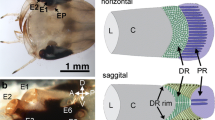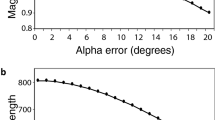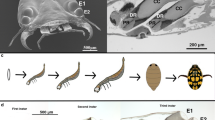Abstract
Larvae of the predaceous diving beetle Thermonectus marmoratus bear six stemmata on each side of their head, two of which form relatively long tubes with linear retinas at their proximal ends. The physical organization of these eyes results in extremely narrow visual fields that extend only laterally in the horizontal body plane. There are other examples of animals possessing eyes with predominantly linear retinas, or with linear arrangements of specific receptor types. In these animals, the eyes, or parts of the eyes, are movable and perform scanning movements to increase the visual field. Based on anatomical data and observations of relatively transparent, immobilized young larvae, we report here that T. marmoratus larvae are incapable of moving their eyes or any part of their eyes within the head capsule. However, they do perform a series of bodily dorso-ventral pivots prior to prey capture, behaviorally extending the vertical visual field from 2° to up to 50°. Frame-by-frame analysis shows that such behavior is performed within a characteristic distance to the prey. These data provide first insights into the function of the very peculiar anatomical eye organization of T. marmoratus larvae.








Similar content being viewed by others
Abbreviations
- E1:
-
Eye one
- E2:
-
Eye two
- E3:
-
Eye three
- E4:
-
Eye four
- E5:
-
Eye five
- E6:
-
Eye six
References
Arikawa K, Hicks JL, Williams DS (1990) Identification of actin-filaments in the rhabdomeral microvilli of Drosophila photoreceptors. J Cell Biol 110:1993–1998
Baumann O (1992) Structural interactions of actin-filaments and endoplasmic reticulum in honeybee photoreceptor cells. Cell Tissue Res 268:71–79
Blest AD, Hardie RC, McIntyre P, Williams DS (1981) The spectral sensitivities of identified receptors and the function of retinal tiering in the principal eyes of a jumping spider. J Comp Physiol A 145:227–239
Blumer MJF (1998) Alterations of the eyes of Carinaria lamarcki (Gastropoda, Heteropoda) during the long pelagic cycle. Zoomorphology 118:183–194
Blumer MJF (1999) Development of a unique eye: photoreceptors of the pelagic predator Atlanta peroni (Gastropoda, Heteropoda). Zoomorphology 119:81–91
Cronin TW, Marshall NJ (1989) A retina with at least 10 spectral types of photoreceptors in a mantis shrimp. Nature 339:137–140
Dzimirski I (1959) Untersuchungen über Bewegungssehen und Optomotorik bei Springspinnen (Salticidae). Z Tierpsychol 16:385–402
Gilbert C (1994) Form and function of stemmata in larvae of holometabolous insects. Annu Rev Entomol 39:323–349
Günther K (1912) Die Sehorgane der Larve und Imago von Dytiscus marginalis. Z Wiss Zool 100:60–115
Hafner GS, Tokarski TR, Kipp J (1992) Localization of actin in the retina of the crayfish Procambarus clarkii. J Neurocytol 21:94–104
Hesse R (1900) Untersuchungen über die Organe der Lichtempfindung bei niederen Thieren. VI. Die Augen einiger Mollusken. Z Wiss Zool 68:379–477
Homann H (1928) Beiträge zur Phylogenie der Spinnenaugen. I and II. Z Vergl Physiol 7:201–268
Land MF (1969a) Movements of the retinae of jumping spiders in response to visual stimuli. J Exp Biol 51:471–493
Land MF (1969b) Structure of the retinae of the principal eyes of jumping spiders (Salticidae: Dendryphanatidae) in relation to visual optics. J Exp Biol 51:443–470
Land MF (1971) Orientation by jumping spiders in the absence of visual feedback. J Exp Biol 54:119–139
Land MF (1981) Optics and vision in invertebrates. In: Autrum H (ed) Comparative physiology and evolution of vision in invertebrates. Handbook of sensory physiology. Springer, Berlin, pp 471–592
Land MF (1982) Scanning eye movements in a heteropod mollusc. J Exp Biol 96:427–430
Land MF (1988) The functions of eye and body movements in Labidocera and other copepods. J Exp Biol 140:381–391
Land MF, Marshall JN, Brownless D, Cronin TW (1990) The eye-movements of the mantis shrimp Odontodactylus scyllarus (Crustacea, Stomatopoda). J Comp Phys A 167:155–166
Land MF, Nilsson DE (2002) Animal eyes. Oxford University Press, Oxford
Larson DJ, Alarie Y, Roughley RE (2000) Predaceous diving beetles (Coleoptera: Dytiscidae) of the Nearctic region. NRC Research Press, Ottawa
Lin JT, Hwang PC, Tung LC (2002) Visual organization and spectral sensitivity of larval eyes in the moth Trabala vishnou Lefebur (Lepidoptera: Lasiocampidae). Zool Stud 41:366–375
Mandapaka K, Morgan RC, Buschbeck EK (2006) Twenty-eight retinas but only twelve eyes; an anatomical analysis of the larval visual system of the diving beetle Thermonectus marmoratus (Dytiscidae: Coleoptera). J Comp Neurol 497:166–181
Marshall NJ, Land MF, Cronin TW (1994) The 6-eyed stomatopod. Endeavour 18:17–26
Melzer RR, Paulus HF (1991) Morphology of the visual-system of Chaoborus-crystallinus (Diptera, Chaoboridae). 1. Larval compound eyes and stemmata. Zoomorphology 110:227–238
Melzer RR, Paulus HF, Kristensen NP (1994) The larval eye of nannochoristid scorpionflies (Insecta, Mecoptera). Acta Zool 75:201–208
Mizutani A, Toh Y (1987) Visual system of the tiger beetle (Cicindela chinensis) larva. 2. Electrophysiology. Zool Sci 4:975–975
Mizutani A, Toh Y (1995) Optical and physiological properties of the larval visual system of the tiger beetle, Cicindela chinensis. J Comp Physiol A 177:591–599
Morgan RC (1992) Natural history, captive management and the display of the sunburst diving beetle Thermonectus marmoratus. AAZPA/CAZPA Ann Conf Proc 1992:457–464
Morgan RC (1995) Sunburst diving beetle Thermonectus marmoratus biology, husbandry and display. Invertebr Captivity Conf Proc 50–57
Nilsson DE (1989) Optics and evolution of compound eyes. In: Stavenga DG, Hardie RC (eds) Facets of vision. Springer, Berlin, pp 30–73
Patten W (1888) Studies on the eyes of arthropods. II Eyes of Acilius. J Morphol 2:97–190
Peaslee AG, Wilson G (1989) Spectral sensitivity in jumping spiders (Araneae, Salticidae). J Comp Physiol A Sens Neural Behav Physiol 164:359–363
Scheuring L (1913–1914) Die Augen der Arachnoiden. II. Zool Jb (Anat) 37:369–464
Sherk TE (1978) Development of the compound eyes of dragonflies (Odonata) III. Adult compound eyes. J Exp Zool 203:61–80
Srinivasan MV, Bernard GD (1975) The effect of motion on visual acuity of the compound eye: A theoretical analysis. Vis Res 15:515–525
Toh Y, Mizutani A (1987) Visual system of the tiger beetle (Cicindela chinensis) larva. 1. Structure. Zool Sci 4:974–974
Toh Y, Mizutani A (1994) Structure of the visual system of the larva of the tiger beetle (Cicindela chinensis). Cell Tissue Res 278:125–134
Warrant E, Nilsson DE (2006) Invertebrate vision. Cambridge University Press, Cambridge
Acknowledgments
We thank Drs John Layne, Birgit Ehmer and Ilya Vilinsky for helpful discussions and comments on the manuscript, Karunyakanth Mandapaka and Heather Hoy for technical assistance, and Phillip Ross for his help in the behavioral analysis. This work has been supported by NSF (IOB-0545978).
Author information
Authors and Affiliations
Corresponding author
Rights and permissions
About this article
Cite this article
Buschbeck, E.K., Sbita, S.J. & Morgan, R.C. Scanning behavior by larvae of the predacious diving beetle, Thermonectus marmoratus (Coleoptera: Dytiscidae) enlarges visual field prior to prey capture. J Comp Physiol A 193, 973–982 (2007). https://doi.org/10.1007/s00359-007-0250-x
Received:
Revised:
Accepted:
Published:
Issue Date:
DOI: https://doi.org/10.1007/s00359-007-0250-x




